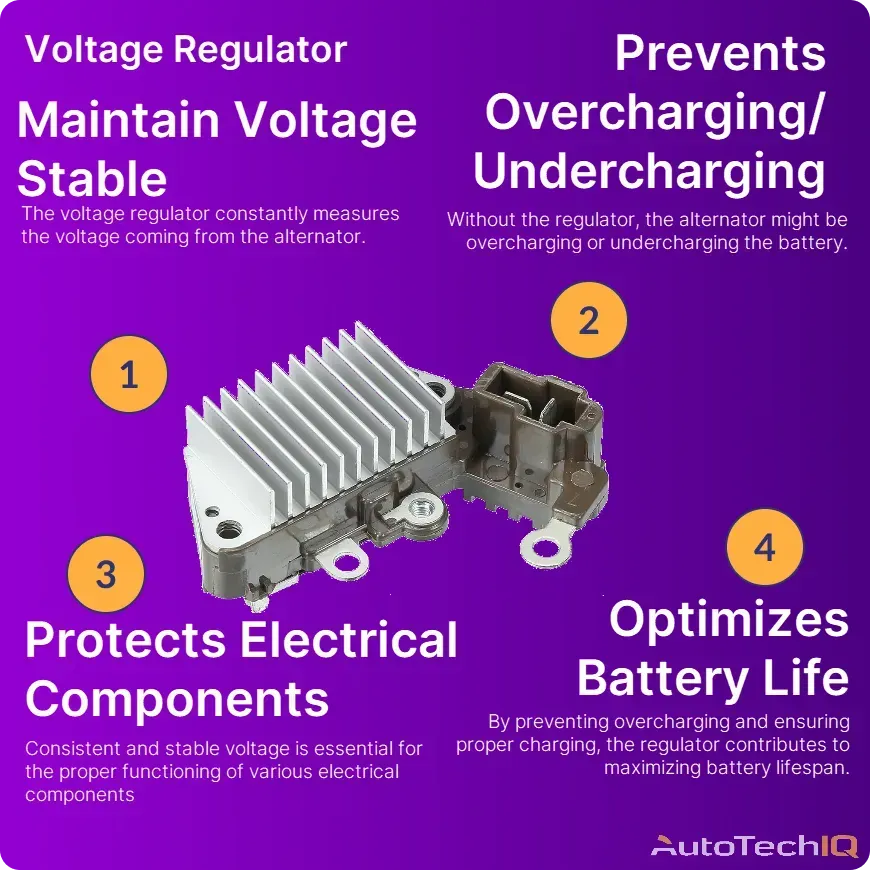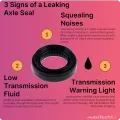
In a vehicle, a voltage regulator is a crucial component of the electrical system that plays a vital role in ensuring its smooth operation and protecting its various components. In a short and technical sense, it defines the system's output voltage by controlling the input voltage it reads. Here's a breakdown of its function:
Function
- Maintaining Stable Voltage: The voltage regulator constantly measures the voltage coming from the alternator. The alternator is the part that generates electricity for the car's electrical system. So, the voltage regulator ensures that the constant voltage ("energy amount" the alternator provides) stays within a safe and optimal range, typically around 13.5 to 14.5 volts. Remember that too much voltage is dangerous and can melt connections and wires, whereas too little is ineffective. So, these components work like "linear voltage regulators," always preventing voltage oscillations.

- Preventing Overcharging and Undercharging: Without the regulator, the alternator's constant output voltage could act odd, leading to overcharging or undercharging of the battery. Overcharging can damage the battery and shorten its lifespan while undercharging can leave the car without enough power to start or run properly. So, the regulator always ensures a desired output voltage.

- Protecting Electrical Components: Consistent and stable voltage is essential for the proper functioning of various electrical components in your car, such as lights, air conditioners, radios, computers, and engine control units. Voltage fluctuations can damage these sensitive components.

- Optimizing Battery Life: By preventing overcharging and ensuring proper charging, the regulator contributes to maximizing battery lifespan.
How it Works
- Monitoring and Adjustment: The voltage regulator continuously measures the voltage output from the alternator. It compares this reading to a reference voltage and makes adjustments as needed. Note that most modern vehicle voltages are controlled by the vehicle's computer system.
- Control Mechanism: The regulator typically controls the alternator's output by adjusting the current flowing through its field coil. By increasing or decreasing the current, the regulator can influence the magnetic field strength in the alternator, thereby regulating the voltage it generates. They're like "linear regulators," always ensuring the voltage doesn't oscillate.
- Types of Regulators: Modern vehicles typically use solid-state voltage regulators, aka a linear regulator, which are more efficient and reliable than older mechanical regulators.
Importance
- Prevents Damage: A properly functioning voltage regulator helps prevent damage to the battery, electrical components, and the alternator itself.
- Ensures Smooth Operation: Stable voltage contributes to the smooth operation of the car's electrical system, preventing issues like flickering lights, erratic instrument readings, or difficulty starting the car.
- Extends Lifespan: By protecting components and ensuring proper operation, a voltage regulator can help extend the lifespan of your vehicle's electrical system.
What happens when a voltage regulator goes bad?
A failing voltage regulator can cause several problems in your vehicle, ranging from minor annoyances to major breakdowns. Remember that a linear voltage regulator is a working one, so any oscillation in voltage output should be a bad sign. Here's a breakdown of how a bad voltage regulator can impact your car:
Battery Issues:
Most battery issues can be detected through preventative maintenance before they build up and become serious matters.
- Undercharging: The most common issue is the regulator failing to properly control the alternator's output. This can lead to undercharging, where the battery doesn't receive enough power to stay fully charged. This can manifest as:
- Difficulty starting the car, especially if the battery is already in poor condition.
- Dimming lights and other electrical components when the engine is idling.
- Warning lights on the dashboard, like the battery light.

- Overcharging: Conversely, the regulator could overcharge the battery by sending a higher output voltage. This can cause:
- Battery damage, shortening its lifespan and potentially leading to leaks or bulging.
- Excessive heat in the battery compartment poses a fire risk.
- Damage to other electrical components due to high voltage exposure.
Electrical System Problems:
- Fluctuating Voltage: A "switching regulator," that is, an erratic voltage regulator can cause the voltage supplied to the electrical system to fluctuate. This can lead to:
- Flickering lights, both interior and exterior.
- Erratic behavior of electronic components, like the radio, gauges, or even engine control units.
- Potential damage to sensitive electronic components due to voltage spikes.
Engine Performance Issues:
- In extreme cases, a failing voltage regulator can even affect engine performance. This is because some engine control units rely on a stable voltage supply for proper operation. Fluctuations can lead to:
- Rough idling or engine stalling.
- Reduced power and performance.
- The "check engine" light turning on.
Prevention and Solutions:
- Symptoms like flickering lights, battery issues, or erratic electrical behavior should be taken seriously as they could indicate a faulty voltage regulator. Switching regulators to ensure proper voltage regulator control.
- It's essential to get your car diagnosed by a qualified mechanic to confirm the issue and replace the voltage regulator if necessary. Call a Shop nearby (you can find one here).
- Regularly scheduled maintenance, including checking the charging system and battery health, can help identify potential issues early on and ensure the system gets a fixed output voltage.
Other news
-
Car is Squealing When Driving

-
What is Preventative Maintenance and What Are The Benefits of it?

-
JobViewIQ - DVI Process Training - Part of the Auto Care Alliance Benefits

-
7 Signs of Clogged AC Components

-
How Much Does a Transmission Fluid Change Cost?

-
7 Signs of a Leaking Axle Seal

-
8 Signs of a Bad Brake Pad
